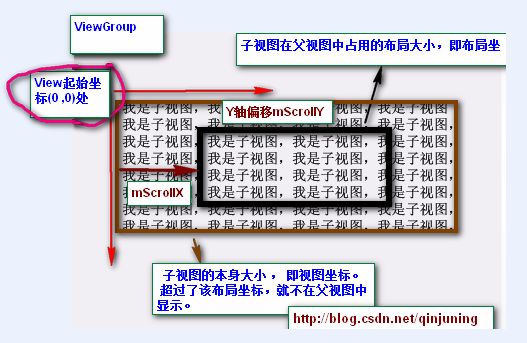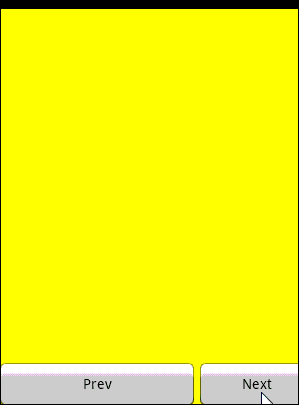android 布局之滑动探究 scrollTo 和 scrollBy 方法使用说明
在Android View视图是没有边界的,Canvas是没有边界的,只不过我们通过绘制特定的View时对 Canvas对象进行了一定的操作,例如 : translate(平移)、clipRect(剪切)等,以便达到我们的对该Canvas对象绘制的要求 ,我们可以将这种无边界的视图称为“视图坐标”-----它不受物理屏幕限制。通常我们所理解的一个Layout布局文件只是该视图的显示区域,超过了这个显示区域将不能显示到父视图的区域中 ,对应的,我们可以将这种有边界的视图称为“布局坐标”------ 父视图给子视图分配的布局(layout)大小。而且, 一个视图的在屏幕的起始坐标位于视图坐标起始处,如下图所示。注意偏移量的正负方向。
其实是相对于父类视图的左上角坐标为原点(0,0),而不是整体ViewGroup的左上角为原点。
由于布局坐标只能显示特定的一块内容,所以我们只有移动布局坐标的坐标原点就可以将视图坐标的任何位置显示出来。
(注:例如cocos2D的布局就和android的布局坐标原点坐标不一样,是左下角会原点,所以会有所差异。)
黑色框框表示该子视图的布局坐标, 褐色框框表示该子视图的视图坐标--该坐标是无限的,超过了父视图给子视图
规定的区域后,不再显示该超出内容。
那么下面的问题就是:如何将我们的视图的任意坐标能显示到该视图的中心坐标上呢? 由于该布局位置是只能显示特定的
一块视图内容 ,因此我们需要通过scrollTo()或者scrollBy()方法将我们期望的视图“滚动”至布局坐标上。
在View.java中提供了了如下两个变量以及相应的属性方法去读取滚动值 ,如下: View.java类中
01 |
/** |
02 |
* The offset, in pixels, by which the content of this view is scrolled |
03 |
* horizontally. |
04 |
* {@hide} |
05 |
*/ |
06 |
protected int mScrollX; //该视图内容相当于视图起始坐标的偏移量 , X轴 方向 |
07 |
/** |
08 |
* The offset, in pixels, by which the content of this view is scrolled |
09 |
* vertically. |
10 |
* {@hide} |
11 |
*/ |
12 |
protected int mScrollY; //该视图内容相当于视图起始坐标的偏移量 , Y轴方向 |
13 |
14 |
/** |
15 |
* Return the scrolled left position of this view. This is the left edge of |
16 |
* the displayed part of your view. You do not need to draw any pixels |
17 |
* farther left, since those are outside of the frame of your view on |
18 |
* screen. |
19 |
* |
20 |
* @return The left edge of the displayed part of your view, in pixels. |
21 |
*/ |
22 |
public final int getScrollX() { |
23 |
return mScrollX; |
24 |
} |
25 |
26 |
/** |
27 |
* Return the scrolled top position of this view. This is the top edge of |
28 |
* the displayed part of your view. You do not need to draw any pixels above |
29 |
* it, since those are outside of the frame of your view on screen. |
30 |
* |
31 |
* @return The top edge of the displayed part of your view, in pixels. |
32 |
*/ |
33 |
public final int getScrollY() { |
34 |
return mScrollY; |
35 |
} |
注意,所谓的“by which the content of this view is scrolled”表示该偏移量只针对于该View中onDraw()方法里的
具体内容实现,而不针对背景图片等 。具体原因可参考<Android中View绘制流程以及invalidate()等相关方法分析>
提示:下文中提到的当前视图内容是在绘制在布局坐标处的内容。
public void scrollTo(int x, int y)
说明:在当前视图内容偏移至(x , y)坐标处,即显示(可视)区域位于(x , y)坐标处。
方法原型为: View.java类中
01 |
/** |
02 |
* Set the scrolled position of your view. This will cause a call to |
03 |
* {@link #onScrollChanged(int, int, int, int)} and the view will be |
04 |
* invalidated. |
05 |
* @param x the x position to scroll to |
06 |
* @param y the y position to scroll to |
07 |
*/ |
08 |
public void scrollTo(int x, int y) { |
09 |
//偏移位置发生了改变 |
10 |
if (mScrollX != x || mScrollY != y) { |
11 |
int oldX = mScrollX; |
12 |
int oldY = mScrollY; |
13 |
mScrollX = x; //赋新值,保存当前便宜量 |
14 |
mScrollY = y; |
15 |
//回调onScrollChanged方法 |
16 |
onScrollChanged(mScrollX, mScrollY, oldX, oldY); |
17 |
if (!awakenScrollBars()) { |
18 |
invalidate(); //一般都引起重绘 |
19 |
} |
20 |
} |
21 |
} |
public voidscrollBy(int x, int y)
说明:在当前视图内容继续偏移(x , y)个单位,显示(可视)区域也跟着偏移(x,y)个单位。
方法原型为: View.java类中
01 |
/** |
02 |
* Move the scrolled position of your view. This will cause a call to |
03 |
* {@link #onScrollChanged(int, int, int, int)} and the view will be |
04 |
* invalidated. |
05 |
* @param x the amount of pixels to scroll by horizontally |
06 |
* @param y the amount of pixels to scroll by vertically |
07 |
*/ |
08 |
// 看出原因了吧 。。 mScrollX 与 mScrollY 代表我们当前偏移的位置 , 在当前位置继续偏移(x ,y)个单位 |
09 |
public void scrollBy(int x, int y) { |
10 |
scrollTo(mScrollX + x, mScrollY + y); |
11 |
} |
第一个小Demo非常简单 ,大家重点理解与掌握scrollTo() 与 scrollBy()函数的用法和区别。
第二个小Demo则有了Launcher的模样,能够左右切换屏幕 。实现功能如下: 采用了一个自定义ViewGroup,该ViewGroup
对象包含了3个LinearLayout子视图,并且以一定的布局坐标(由layout()方法指定)显示在ViewGroup上。 接下来,即可调用该
ViewGroup对象的scrollTo或者scrollBy()方法切换指定视图内容了,即切换屏幕。 呵呵 ,挺好玩的吧 。
如果对View绘制流程不懂的,可以参考我的这篇博客<Android中View绘制流程以及invalidate()等相关方法分析> 。
截图如下:
自定义ViewGroup如下:
01 |
//自定义ViewGroup , 包含了三个LinearLayout控件,存放在不同的布局位置,通过scrollBy或者scrollTo方法切换 |
02 |
public class MultiViewGroup extends ViewGroup { |
03 |
04 |
private Context mContext; |
05 |
06 |
private static String TAG = "MultiViewGroup"; |
07 |
08 |
public MultiViewGroup(Context context) { |
09 |
super(context); |
10 |
mContext = context; |
11 |
init(); |
12 |
} |
13 |
14 |
public MultiViewGroup(Context context, AttributeSet attrs) { |
15 |
super(context, attrs); |
16 |
mContext = context; |
17 |
init(); |
18 |
} |
19 |
20 |
private void init() { |
21 |
// 初始化3个 LinearLayout控件 |
22 |
LinearLayout oneLL = new LinearLayout(mContext); |
23 |
oneLL.setBackgroundColor(Color.RED); |
24 |
addView(oneLL); |
25 |
|
26 |
LinearLayout twoLL = new LinearLayout(mContext); |
27 |
twoLL.setBackgroundColor(Color.YELLOW); |
28 |
addView(twoLL); |
29 |
|
30 |
LinearLayout threeLL = new LinearLayout(mContext); |
31 |
threeLL.setBackgroundColor(Color.BLUE); |
32 |
addView(threeLL); |
33 |
} |
34 |
35 |
// measure过程 |
36 |
@Override |
37 |
protected void onMeasure(int widthMeasureSpec, int heightMeasureSpec) { |
38 |
39 |
Log.i(TAG, "--- start onMeasure --"); |
40 |
41 |
// 设置该ViewGroup的大小 |
42 |
int width = MeasureSpec.getSize(widthMeasureSpec); |
43 |
int height = MeasureSpec.getSize(heightMeasureSpec); |
44 |
setMeasuredDimension(width, height); |
45 |
46 |
int childCount = getChildCount(); |
47 |
Log.i(TAG, "--- onMeasure childCount is -->" + childCount); |
48 |
for (int i = 0; i < childCount; i++) { |
49 |
View child = getChildAt(i); |
50 |
// 设置每个子视图的大小 , 即全屏 |
51 |
child.measure(MultiScreenActivity.screenWidth, MultiScreenActivity.scrrenHeight); |
52 |
} |
53 |
} |
54 |
55 |
// layout过程 |
56 |
@Override |
57 |
protected void onLayout(boolean changed, int l, int t, int r, int b) { |
58 |
// TODO Auto-generated method stub |
59 |
Log.i(TAG, "--- start onLayout --"); |
60 |
int startLeft = 0; // 每个子视图的起始布局坐标 |
61 |
int startTop = 10; // 间距设置为10px 相当于 android:marginTop= "10px" |
62 |
int childCount = getChildCount(); |
63 |
Log.i(TAG, "--- onLayout childCount is -->" + childCount); |
64 |
for (int i = 0; i < childCount; i++) { |
65 |
View child = getChildAt(i); |
66 |
child.layout(startLeft, startTop, |
67 |
startLeft + MultiScreenActivity.screenWidth, |
68 |
startTop + MultiScreenActivity.scrrenHeight); |
69 |
startLeft = startLeft + MultiScreenActivity.screenWidth ; //校准每个子View的起始布局位置 |
70 |
//三个子视图的在屏幕中的分布如下 [0 , 320] / [320,640] / [640,960] |
71 |
} |
72 |
} |
73 |
74 |
} |
PS :大家可以分别给这几个LinearLayout试着添加几个子View,例如TextView, Button等 。
至于Launcher上滑屏功能的实现,我尝试着去掌握,可能天资愚钝吧,对Scoller类很是感冒,现今还没有掌握好,不过在此
- <span style="font-family:SimSun;font-size:14px;"> /**
- * The offset, in pixels, by which the content of this view is scrolled
- * horizontally.
- * {@hide}
- */
- @ViewDebug.ExportedProperty(category = "scrolling")
- protected int mScrollX;
- /**
- * The offset, in pixels, by which the content of this view is scrolled
- * vertically.
- * {@hide}
- */
- @ViewDebug.ExportedProperty(category = "scrolling")
- protected int mScrollY;
- /**
- * Return the scrolled left position of this view. This is the left edge of
- * the displayed part of your view. You do not need to draw any pixels
- * farther left, since those are outside of the frame of your view on
- * screen.
- *
- * @return The left edge of the displayed part of your view, in pixels.
- */
- public final int getScrollX() {
- return mScrollX;
- }
- /**
- * Return the scrolled top position of this view. This is the top edge of
- * the displayed part of your view. You do not need to draw any pixels above
- * it, since those are outside of the frame of your view on screen.
- *
- * @return The top edge of the displayed part of your view, in pixels.
- */
- public final int getScrollY() {
- return mScrollY;
- }</span>
mScrollX:表示离视图起始位置的x水平方向的偏移量
mScrollY:表示离视图起始位置的y垂直方向的偏移量
分别通过getScrollX() 和getScrollY()方法获得。
注意:mScrollX和mScrollY指的并不是坐标,而是偏移量。
- <span style="font-family:SimSun;font-size:14px;"> /**
- * Set the scrolled position of your view. This will cause a call to
- * {@link #onScrollChanged(int, int, int, int)} and the view will be
- * invalidated.
- * @param x the x position to scroll to
- * @param y the y position to scroll to
- */
- public void scrollTo(int x, int y) {
- if (mScrollX != x || mScrollY != y) {
- int oldX = mScrollX;
- int oldY = mScrollY;
- mScrollX = x;
- mScrollY = y;
- invalidateParentCaches();
- onScrollChanged(mScrollX, mScrollY, oldX, oldY);
- if (!awakenScrollBars()) {
- postInvalidateOnAnimation();
- }
- }
- }
- /**
- * Move the scrolled position of your view. This will cause a call to
- * {@link #onScrollChanged(int, int, int, int)} and the view will be
- * invalidated.
- * @param x the amount of pixels to scroll by horizontally
- * @param y the amount of pixels to scroll by vertically
- */
- public void scrollBy(int x, int y) {
- scrollTo(mScrollX + x, mScrollY + y);
- }</span>
从以上的代码可以看出, scrollTo 和 scrollBy区别,其实2者的效果是一样的。
scrollTo(int x,int y):
如果偏移位置发生了改变,就会给mScrollX和mScrollY赋新值,改变当前位置。
注意:x,y代表的不是坐标点,而是偏移量。
例如:
我要移动view到坐标点(100,100),那么我的偏移量就是(0,,0) - (100,100) = (-100 ,-100) ,我就要执行view.scrollTo(-100,-100),达到这个效果。
scrollBy(int x,int y):
从源码中看出,它实际上是调用了scrollTo(mScrollX + x, mScrollY + y);
mScrollX + x和mScrollY + y,即表示在原先偏移的基础上在发生偏移,通俗的说就是相对我们当前位置偏移。
根据父类VIEW里面移动,如果移动到了超出的地方,就不会显示。
查看上文中的示意图你就会知道大概。
下面通过一个小例子了解下这2个方法之间的的使用,
效果图如下:



